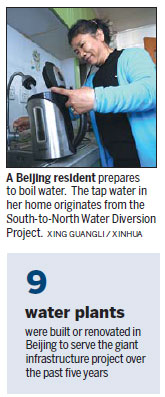Locals in fervent praise of aqua pura from the south
Wang Dongmei, a Beijing resident, spoke highly of the water that comes from the South-to-North Water Diversion Project and is available to her residential community.
"The quality of water here was poor before, with high alkali levels and heavy incrustation, so every family in the residential neighborhood had to install water purifiers or buy barreled water," she said.
But the huge national project, which diverts Yangtze River water into Beijing, changed all that, piping clear water into the region.
"Now the water quality has improved," Wang said.

Wang is among more than 11 million residents in Beijing who have benefited from the project over the past three years.
Before the initial phase of the project's central route was put into operation at the end of 2014, it took around three years to complete a raft of engineering projects to a tight schedule.
One of the projects is a 44.7-kilometer-long trunk canal built in the east of Beijing to carry water, which cost 9.17 billion yuan ($1.4 billion). After four years of preparation, its construction began in June 2012.
Despite geographical complexities, the underground canal runs beneath four railways, nine transit rail lines, nine expressways, 77 bridges and 31 highways. The project involves more than 600 underground pipelines.
With innovative designs and engineering expertise, the builders of the canal created many records in the construction of China's hydraulic projects.
The building teams involved have over the past five years completed four such water tunnels - at a total length of close to 300 km - as part of the South-to-North Water Diversion Project.
The tunnels joined a widespread waterway system, enabling the diverted water originating from Danjiangkou Reservoir in Hubei province to flow to Beijing after traveling 15 days.
The Beijing government has invested heavily in adding and renovating nine water plants, to better serve the South-to-North Water Diversion Project.
They pipe in about 3.6 million cubic meters of water daily, according to the Beijing office of the South-to-North Water Diversion Project.
The local authorities have also innovated Beijing's water delivery model with ring-road routes, which taps into surface water, diverted water from outside the city and groundwater, and connects them with major water plants.
Government data shows that 70 percent of the water from southern China to Beijing is used as tap water, 13 percent goes to reservoirs and 17 percent supplements groundwater, as well as lakes and rivers in Beijing's urban areas.
The water distribution network is aligned with Beijing's development plan. As Tongzhou district was designated as a sub-administrative center of Beijing in 2012, construction on Tongzhou Water Plant was given a priority as part of the South-to-North Water Diversion Project.
One of the first batch of infrastructure projects in the district, the initial phase of the plant was put into use ahead of schedule.
After its second and third phases are completed, the plant will be able to supply 600,000 cu m of water a day, meeting the demand for water for the entire 906 sq km district, local officials said.
As construction on a new airport is progressing in Daxing district in the south of Beijing, the Beijing and Hebei province authorities have decided to build a new water pipeline linking the two regions. This will add 100 million to 150 million cu m of water supply to Beijing a year.
In addition, with the integrated development of Beijing, Tianjin and Hebei, the three regions have started research into connectivity between Baiyangdian Lake in Hebei and Yongding River running through Beijing.
The project is expected to promote coordinated, highly efficient use of water resources in the Beijing-Tianjin-Hebei region, industry insiders said.
(China Daily 12/27/2017 page7)














